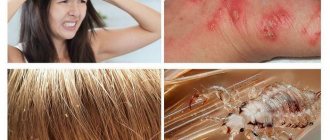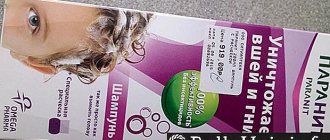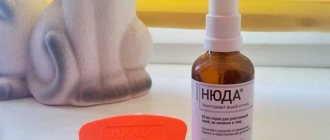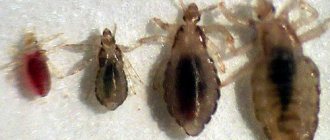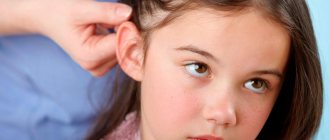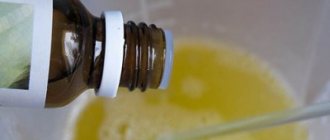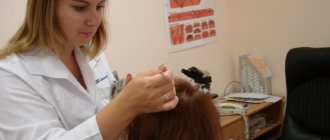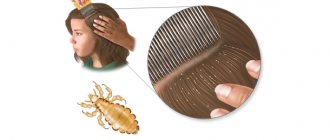Prevention of head lice
Pediculosis. Prevention and control measures
A.I. FROLOVA, Ph.D. biol. Sciences, Associate Professor Department of Disinfectology IPO First Moscow State Medical University named after. THEM. Sechenova, leading researcher of the department of scientific problems of disinsection of the Federal Budgetary Institution "Research Institute of Disinfectology" of Rospotrebnadzor, Moscow
Summer has arrived, which means a favorable season for the spread of lice. Let's consider what measures to prevent and control pediculosis.
Types of lice and their characteristics
There are three types of lice: head, body and pubic.
Head lice live and breed in the scalp, preferably on the temples, back of the head and crown. They feed every 2–3 hours. They do not tolerate hunger well; at +30 °C they usually die within a day. Development of eggs occurs within 5–9 days, larvae – 15–17 days. The lifespan of adults is 27–30 days. Females lay 3-7 eggs daily, and throughout their lives - from 38 to 140 eggs. They are very sensitive to changes in temperature and humidity, the optimum temperature is about +28 °C. When the temperature drops, development slows down; at +20 °C the female stops laying eggs, and the development of larvae stops. Outside the host's body, the louse dies within a day.
The body louse lives in the folds of linen and dresses, especially in the seams, where it lays eggs, gluing them to the fibers of the fabric. Eggs can also stick to hair on the human body, except the head. Eats 2–3 times a day; saturates in 3–10 minutes, drinks noticeably more blood at a time than the head. Lays about 10 eggs daily, during life on average about 200, with a maximum of 300. Eggs develop within 7–14 days, larvae – 14–18 days. The average lifespan of adults is 34 days, with a maximum of 46 days. The optimal development temperature for body lice is 2–4 °C higher than for head lice – 30–32 °C. At 25–30 °C they can fast for 2–3 days, and when the temperature drops to 10–20 °C they can fast for about a week. All stages of development, including the egg, are very sensitive to temperatures above +37 °C. Lice tolerate dry heat (47–50 °C) for up to 10 minutes and then die. Lice tolerate low temperatures and high humidity much better. At -13 °C they remain viable for up to 7 days, in water they remain alive for up to 2 days.
The negative relationship of lice to high temperatures is of epidemiological significance, since lice leave feverish patients and can crawl onto surrounding healthy people.
The pubic louse, or flat louse , is the smallest of human lice. With significant numbers, insects can spread over the entire lower part of the body, especially on the stomach, where, as a result of their blood-sucking, characteristic bluish marks remain for a long time. The pubic louse is inactive, usually remains in place, plunging its proboscis into the human skin, and drinks blood often with short breaks. Fecundity is low: the female lays no more than 50 eggs during her life. The eggs hatch into first-instar larvae, which later develop into second- and third-instar larvae. Each phase of larval development takes 5–7 days, and the female’s lifespan is about 1 month. Outside of humans, a living creature can only live for 10–12 hours.
Symptoms of lice
Symptoms of pediculosis are described as:
- Itching, accompanied by scratching and, in some people, allergies.
- Coarsening of the skin from massive lice bites and exposure to saliva.
- Melasma is skin pigmentation due to tissue hemorrhages and an inflammatory process caused by exposure to saliva.
- A tangle formed when scratching the scalp. The hair becomes tangled and sticks together with purulent-serous secretions, which dry out in crusts on the head, and underneath there is a weeping purulent surface. Koltun is a rather rare occurrence.
Pediculosis is often complicated by pyoderma. It develops due to the penetration of a secondary bacterial infection through skin lesions caused by scratching lice bites. With widespread pyoderma, regional lymphadenitis may be observed.
How does lice infection occur?
People can become infected with head and body lice through close contact with a person infected with lice. For example, when children communicate in groups (kindergartens, boarding schools, labor and recreation camps, etc.), as well as in crowded transport, in crowded places, in swimming pools and when using common objects - combs, hats, clothes , bedding, etc.
When infected with pubic lice (phthiriasis), the lice crawl from person to person mainly through intimate contact (95%). Less commonly, these insects can get on a person when washing in public baths, massage rooms, hotels through bedding.
In large cities, the prevalence of lice is higher. This is due both to the identification of patients when people go to sanitary checkpoints, and to social factors.
In Moscow, the incidence of head lice in adults is almost 8 times higher than the Russian average.
A large influx of migrants is rushing to the cities, some of whom become homeless. The proportion of this category of the population among those affected by pediculosis is extremely large. On average, about half a million homeless people are examined annually, with more than 7 thousand infected with head lice and more than 170 thousand infected with body lice. Consequently, being a risk group for pediculosis, homeless people become ill more often than other groups of the population and create uncontrolled foci of infection around themselves. This threatens outbreaks of diseases whose pathogens are transmitted by lice [2].
Lice as carriers of dangerous infections
The importance of human lice species as carriers of pathogens of infectious diseases varies. The greatest epidemiological danger is posed by body lice, whose role has been proven epidemiologically and experimentally. They are carriers of pathogens of epidemic typhus and relapsing fever, Volyn fever.
Lice, having drunk the blood of a patient containing pathogens of typhus or relapsing fever, after 4–7 days become capable of transmitting pathogens to a healthy person.
A person becomes infected with these diseases when secretions of infected lice get on the mucous membranes, in wounds in places of scratching, skin damage, or when an insect is crushed. Even if lice excrement gets on clothing, the risk of disease remains, since rickettsiae are viable and pathogenic for up to three months or more.
In relapsing typhus, the causative agent - a spirochete (Borrellia recurrentis) - enters the stomach of the lice with the blood of the patient, and then into the lymph. A person becomes infected from infected lice by crushing them, introducing spirochetes into the superficial areas of the skin when scratching or on the mucous membranes.
The head louse is currently considered as a possible carrier of the causative agents of epidemic typhus and relapsing fever. However, it is known that in the experiment, the infection of head lice with Provacek's rickettsia is 30% lower than that of body lice.
The pubic louse has virtually no epidemiological significance, however, just like body and head lice, it causes great concern to a person, causing severe itching. With strong scratching, various pustular skin diseases and exacerbation of dermatitis and eczema may occur.
Preventive and exterminatory measures to combat pediculosis
The fight against lice includes a complex of preventive and exterminatory measures.
Preventive measures include scheduled examinations of organized groups of the population, their sanitary treatment, compliance with the sanitary and anti-epidemic regime in organized groups, compliance with personal hygiene rules, and carrying out sanitary educational work among the population. In Appendix 1 we provide a reminder that you can use for sanitary education work.
The complex of extermination measures includes the simultaneous destruction of lice on the human body, underwear, clothing, bedding and in the home. Thus, measures to combat pediculosis are carried out not only for epidemiological, but also for sanitary indications.
It is prohibited to refuse hospitalization for the underlying disease due to detected lice.
Methods for killing lice
Disinsection measures to combat lice include three methods: mechanical, physical and chemical.
MECHANICAL METHOD
The mechanical method of exterminating head lice is recommended for pregnant and lactating women and children under five years of age, as well as children and adolescents who are sensitive to cosmetics or suffer from allergic diseases. The method involves combing out lice and eggs with a fine-toothed comb every 5–7 days or cutting the hair. To remove nits more easily, you should use 4.5–10% acetic acid or table vinegar in the same concentration for rinsing hair or applications.
PHYSICAL METHOD
The physical method - the use of low and high temperatures - is recommended for body lice to kill body lice.
When things and bedding are frozen in the cold for an hour from -13 °C, insects die and from -25 °C - lice eggs.
Boiling laundry and ironing things with a hot iron or treating clothes and bedding in disinfection chambers can destroy adult insects, larvae and lice eggs within 20–90 minutes, depending on the disinsection method.
CHEMICAL METHOD
The chemical method - the use of pediculicides - is still the main method for killing lice.
This method can be used to combat three types of lice (head, pubic and body lice), as well as for disinsection of premises in areas of lice. Chemical agents (pediculicides) are used in a variety of formulations: lotions, shampoos, insecticidal soaps, emulsion concentrates, and aerosol products.
Pediculicides should be used strictly in accordance with the label or instructions for use of the product. Basically, they are not approved for use by children under 5 years of age, pregnant and lactating women, as well as people prone to allergies and sensitive to cosmetics and medications.
Since pediculicides are cutaneous agents, there are limitations to their development and use. The range of compounds that can be used as active ingredients is limited: pyrethrins that do not contain a CN group, pyrethroids and organophosphorus compounds. They mainly use synthetic pyrethroids (permethrin, phenothrin, bioallethrin), as well as natural compounds - pyrethrins from extracts of Dalmatian or Caucasian chamomile. From the group of organophosphorus compounds – malathion (karbofos), fenthion. Solvents of active substances included in pediculicide formulations: water, alcohols (ethyl or isopropyl), deodorized and regular kerosene. The composition of the products also includes substances used as functional additives that increase the effectiveness of pediculicides or stabilize the formulation of the product.
Selection of pediculicides
To destroy head lice when treating scalp hair, various forms are used: emulsion concentrates, lotions, shampoos, soaps based on non-traditional insecticides, mixtures of pyrethroids and organophosphorus compounds (OPS).
Not all pediculicidal agents have an ovicidal effect (against nits). This mainly applies to forms such as insecticidal soaps and shampoos. When using products that have insufficient ovicidal effect, it is recommended to carry out repeated treatments after 7–10 days.
For phthiriasis (pubic louse), eyelashes, eyebrows, beard, armpits, pubis, and hairy parts of the legs are treated. To destroy this type of lice, almost all the same pediculicides are recommended as for the fight against head lice. However, treatment of phthiriasis should be carried out in a regional dermatovenerological clinic so as not to miss sexually transmitted diseases.
For body lice, underwear and bed linen, outerwear, and bedding are treated. Seams and folds are treated especially carefully, as these are favorite places for lice to lay eggs. To kill body lice, emulsion concentrates based on organophosphorus compounds or a mixture of FOS and permethrin are recommended.
For special contingents, means for impregnation (impregnation) of linen and things are recommended.
head (Pediculus humanus capitis De Geer) (Fig. 1),
Rice. 1. Head louse (female)
- Clothes (Fig. 2)
Rice. 2. Body louse (male)
- pubis (Phthyrus pubis L.) (Fig. 3).
Rice. 3. Pubic louse (female)
These types of lice can only feed on human blood, so they parasitize only on humans and you can only become infected with lice from people.
Infection of people with head and body lice can occur through close contact with a person suffering from lice - in crowded transport, in crowded places, in swimming pools, as well as through the use of shared objects - combs, hats, clothes, bedding, etc. .
When infected with pubic lice (phthiriasis), the lice crawl from person to person mainly through intimate contact (95%), less often, these insects can get on a person when washing in public baths, in massage rooms, hotels through bed linen.
The favorite habitats of head lice are the temporo-occipital part of the head (Fig. 4). When the number of insects is high, lice spread throughout the entire scalp.
Rice. 4. Lice eggs (nits) laid on the hair
The habitats of pubic lice are eyelashes, eyebrows, mustaches, beards, pubis, and armpit hair.
Head and pubic lice lay eggs on the hair, attaching them with an adhesive substance secreted by the females (Figure 5).
Rice. 5. Nits (enlarged)
Body lice live mainly in the folds of linen and clothing (especially in the seams), where the females lay eggs (nits), attaching them to the fibers of the fabric with the help of an adhesive substance secreted by them.
When lice suck blood, they secrete a specific substance that prevents blood clotting and causes severe itching, which leads to scratching of the skin, which can lead to dermatitis or eczema.
Body lice are especially dangerous, since they can be carriers of pathogens that cause epidemic typhus, relapsing fever, and Volyn fever.
To prevent lice infection, the main thing is to avoid contact with people infected with lice and observe the rules of personal hygiene: comb your hair thoroughly every day and cut it in a timely manner, if possible, wash daily, change underwear and bed linen as they become dirty, but at least every 7-10 days .
Children should be examined regularly, especially if the child attends kindergarten or school. Particular attention is paid to the occipital and temporal parts of the head. The most obvious sign of lice is the presence of white lumps of nits at the roots of the hair or combed wounds on the scalp caused by lice sucking blood.
For head lice, if a small number of head lice are found (from 1 to 5 insects) that have not yet had time to lay eggs (nits), you can use a fine-toothed comb to comb the lice out of the hair; If the number of body lice is small, the linen can be boiled and outer clothing can be ironed with a hot iron. Especially seams and folds.
In cases where insects have already laid eggs, it is recommended to use special insecticidal agents - pediculicides - designed to kill lice.
Be healthy !!!!
Pediculosis and its prevention
Prevention of head lice
One of the most common parasitic dermatoses caused by arthropods is pediculosis. Pediculosis is widespread throughout the world and is a problem not only in developing but also in economically developed countries.
In recent years, in the Frunzensky district of Minsk, there has been a tendency towards stabilization of the incidence of head lice in the population as a whole, but the incidence of students in general secondary education institutions is significant.
Pediculosis or lice is a specific parasitism of a person by lice that feed on his blood. There are three types of lice that parasitize humans: head, body, and pubic. Body lice, which are carriers of typhus, are of greatest epidemic importance. Possible infection with mixed pediculosis (for example, the simultaneous presence of head and body lice). Stages of lice development: egg (nit) – larva – adult. Head louse - body length 2.0-3.5 mm, lives and reproduces in the scalp, preferably on the temples, back of the head and crown. Feeds every 2-3 hours. The development of eggs (nits) occurs within 5-9 days, larvae 15-17 days. The lifespan of adults is 27-30 days. The female lays 3-7 eggs (nits) daily. Outside the host's body, it dies within a day. Body louse - body length 2.1-4.75 mm, lighter color. The body louse lives in the folds of linen and clothing, especially in the seams, where it lays eggs (nits), gluing them to the fibers of the fabric; eggs (nits) can also stick to hair on the human body. Eats 2-3 times a day. Lays about 10 eggs daily. Eggs develop within 7-14 days, larvae 14-18 days. The average lifespan of adults is 34 days, with a maximum of 46 days. Pubic louse - body length 1.36-1.6 mm, body shape resembles a shield, held on short hairs of the pubis, eyebrows, eyelashes. With significant numbers, insects can spread over the entire lower part of the body.
Symptoms of pediculosis : itching of the skin at the sites of bites, accompanied by scratching and allergies, coarsening and pigmentation of the skin from bites and exposure to insect saliva, the presence of eggs (nits, color - from white to brown, the same round shape, unlike dandruff, they are firmly glued to the hair ), living individuals.
Risk groups include people working in the service sector (hairdressers, baths, laundries, transport, medical and preventive and sports institutions, etc.) who lead an asocial lifestyle. Head lice predominantly affects school-age children, but body lice affects people leading an asocial lifestyle.
Infection occurs through direct close contact with persons affected by lice (head to head), in crowded places (public transport, hairdressers, baths, wardrobes), in everyday life when using shared clothing, bedding, bedding, hats, combs and other personal items.
If head lice is detected, you must contact an outpatient health care facility at your place of residence, or you can also contact medical workers at health care institutions at your place of study or work. A medical worker at a health care institution gives recommendations on the use of anti-pediculosis drugs for the sanitation of head lice at home, as well as on weekly mutual examination of all family members, or on carrying out sanitary treatment in the central sanitary checkpoint of the City Center for Disinfection and Sterilization (hereinafter referred to as the Center for Disinfection and Sterilization) , Minsk, P. Brovki st., 11. 13 entrance, 1st floor. In cases of clothing and mixed forms of lice, treatment of people and their belongings is carried out only by specialists from the Center for Medical Treatment of the State Center for the Treatment of Pediculosis. Opening hours: Monday-Friday from 08.00 to 19.00, Saturday Sunday - days off, telephone for inquiries: 80173557567. The center examines the population for pediculosis and provides treatment services against pediculosis (chemical and mechanical methods). The population is issued certificates: about passing an examination for pediculosis; about undergoing rehabilitation for pediculosis; about monitoring the effectiveness of sanitation against pediculosis. Also, the service for treatment against pediculosis is provided on a paid basis and confidentially. You can view the price list on the website https://www.minsksanepid.by/ Services/Price list for disinfection, pest control and deratization work (services).
Measures to combat lice: when lice are detected at any stage (egg (nit), larva, adult insect), destruction measures should be carried out simultaneously, destroying lice directly both on the human body and on his underwear, clothes and other things.
Mechanical method - in case of minor infestation of people with head lice (from 1 to 10 specimens, including eggs (nits)), combing out insects and eggs (nits) with a fine comb, cutting and shaving the hair, followed by burning.
The physical method is soaking, boiling the linen in a 2% solution of soda ash for 15 minutes, ironing with a hot iron on both sides of the seams, folds, waistbands of the linen and clothes that are not subject to boiling.
The chemical method of treating pediculosis is currently based on the use of pediculicides - insecticides that act on lice and eggs (nits), recommended by the Ministry of Health of the Republic of Belarus, purchased in pharmacies and used in accordance with the instructions for this drug. This treatment is repeated after 7-10 days. After processing and washing the hair, rinse it with a warm 5-10% aqueous solution of acetic acid. Since dead nits remain on the hair, they need to be combed out with a comb and picked out with your hands. To prevent the spread of pediculosis (head lice can spread to clothing and the environment around a person), after completion of the sanitation it is necessary to disinfest the premises and furnishings: irrigate with an aqueous solution of pediculicide, maintain exposure (according to the instructions for use). Ventilate the room thoroughly. Remove pediculicide residues from treated objects and surfaces by wet cleaning as usual.
to prevent head lice ; you must follow the usual personal hygiene rules:
washing the head and body with hot water and soap - as soiled, but at least once every 7 days; regular haircuts, combing of scalp hair and weekly head lice examinations for all family members. If lice is detected in one of the family members, you need to make sure that the rest are not affected. For the purpose of prevention, it is recommended that all family members undergo treatment at the same time and carry out examinations of the scalp for the presence of lice within a month; change of bed linen - when soiled, but at least once every 7 days and washing of linen with boiling and subsequent ironing with a hot iron; systematic change of underwear and washing/cleaning of clothes and outerwear; a complete ban on the use of other people's underwear, clothes, hats, combs and other personal hygiene items; before use, pre-wash or iron new clothes and hats with a hot iron; Regular cleaning of premises, keeping furnishings clean.
Remember!
By observing and instilling hygienic skills in your children, conducting individual prevention in families, weekly examining children and all family members for lice, you can prevent its occurrence in your families.
Prevention and control of head lice are reliable means of preventing typhus.
Epidemiologist
anti-epidemic department
sanitary-epidemiological department
government agency
"Center of Hygiene and Epidemiology
Frunzensky district of Minsk" Melentovich Olga Aleksandrovna
Pediculosis
Origin of parasitosis and evolution of the pathogen
Pediculosis (pediculosis - from the Latin "lice"; rhtheiriasis - from the Greek "damage", "lice") is a common ectoparasitic disease manifested by itchy skin lesions at the site of lice bites, often accompanied by secondary infection, eczematization and other complications. Lice parasitize exclusively on mammals and are adapted to feed on strictly obligate hosts.
pediculosis has ancient origins. As hosts evolved, parasites also underwent some changes. The disappearance of hair on most of the human body led to the fact that the parasites “specialized” in living in certain areas of the skin with hair - and two types of lice were formed: Pediculus humanus and Phthirius pubis (seu inguinalis). Later, thousands of years later, the species Pediculus humanus was divided into two subspecies - Pediculus capitis and Pediculus vestimenti.
Epidemiology of pediculosis
For many centuries, lice were considered an “integral part” of humans. There were even statements that lice were “a positive factor in the natural selection of their hosts.” However, at the beginning of the twentieth century. The role of lice in the spread of anthroponotic blood (vector-borne) infections - classical and epidemic typhus, relapsing typhus, trench (Volyn) fever - was established. Domestic scientists G.N. Minkh, N.F. Gamaleya [4] proved the transmission of these pathogens by body lice, in the stomach of which rickettsia multiplied after sucking infected blood, excreted in feces and embedded in skin wounds. N.F. Gamaleya (1908) emphasized that typhus is contagious only in the presence of lice.
In Russia, pediculosis and transmissible typhus became a pandemic during the civil war of 1918–1920.
At this time, important research was carried out in Russia on the epidemiological significance of pediculosis and methods of combating it, begun by Academician E. N. Pavlovsky and which found full awareness of the importance of this issue among a wide range of doctors and biologists.
The epidemic spread was eliminated, but pediculosis still remained a pressing problem in a number of countries. This is associated with new epidemiological factors - freedom of sexual behavior, tourism, commercial travel, increased migration of people (M. Orkin, H. Maibach, 1999) [6]. Head lice are more often found in children, schoolchildren, and young people. Body lice is less common - mainly in people living in cramped (poor) conditions, in vagabonds, in elderly people who do not maintain hygiene. Pediculosis pubis is registered mainly in young people, as well as people of non-traditional sexual orientation (often simultaneously with sexually transmitted infections). Infants become infected from their parents through bed or when breastfeeding and the mother has lice near the nipple.
Characteristics of parasites
Lice belong to the family Pediculidae of the order Pseudorhynchota. Head lice and body lice have few anatomical differences: body lice are larger in size and have a uniform gray color, while head lice have sharp pigmentation on the sides. The pubic louse is noticeably different from them with a short and wide body, reminiscent of the contours of a crab (the English synonym for the louse is Crab).
Physiological differences are manifested not only in the specificity of the habitat, but also in the frequency of feeding, the intensity of egg laying, and life expectancy (Table 1). The body louse moves extremely quickly, while the pubic louse moves very slowly. All varieties go through the same development cycle: embryonic development in the egg (nit) is 6–8 days, then the hatched larvae molt 3 times in 3–5 days. All of them feed on blood immediately after emerging from the egg. The optimal temperature for their development is 25–27°C.
Clinical picture
Clinical symptoms of lice include the presence of lice on the skin, clothing, nits on hair and underwear, as well as inflammatory skin lesions caused by lice bites, the action of an anticoagulant, sensitization to saliva, lice antigens, irritation and contamination of the skin with their feces. Experiments by Academician E.N. Pavlovsky and A.K. Stein (1924) [8] showed the appearance in the dermis at the site of bites of limited foci of a dense inflammatory infiltrate of neutrophils and lymphocytes with an admixture of eosinophils, edema, extravasation, and vasodilatation. Itching is a common symptom of the skin's reaction to a lice bite. It may be intolerable (especially for body lice at night) or weak (for lice pubis); sometimes its intensity decreases with a decrease in sensitization or due to a person’s adaptation to a chronic lesion. The rash, which appears a few days after the bites, is initially acute (“pruritic acute dermatitis”) in the form of hyperemic spots, urticarial edematous elements, small bright red urticarial papules, vesicles, then turns into chronic dermatitis with inflammatory papules, excoriations, hemorrhagic crusts, lichenification. Later, complications arise with secondary infection, accompanied by lymphadenopathy, febrile episodes, anemia, and microbial eczematization. With phthiriasis pubis and body lice, specific pigmentary changes in the skin occur, and with severe advanced head lice, a tangle in the form of tangled, sticky hair with a putrid odor occurs. Blue spots in phthiriasis are the result of skin staining with the products of hemoglobin destruction by the saliva of the phthisis. Clinical differences between types of lice are characterized by different localization, additional signs and different complications, although lice (including lice) can spread further than their typical habitats; Some people have all three types of lice.
table 2
Diagnostics
Detection of lice or live nits is necessary for an accurate diagnosis. You can use the fluorescence method under a Wood's lamp (which is used by all dermatologists when recognizing trichomycosis and other dermatoses). Living nits fluoresce in a bluish color, while dead nits do not glow and, upon direct inspection, appear gray and dull. The differential diagnosis takes into account possible similarities with pediculosis, pediculous eczema and other complications of pediculosis; also with skin itching, diabetic itching, senile itching, seborrheic eczema, microbial eczema, atopic dermatitis, strophulus (so-called prurigo), senile prurigo, urticaria, Vidal's lichen (limited neurodermatitis), toxicerma, lymphogranulomatosis, primary pyoderma (streptoderma , streptostaphyloderma, staphyloderma), blepharitis and conjunctivitis not associated with phthiriasis, melasma of endocrine or toxic origin, fading syphilitic roseola.
Diagnostics includes mandatory examination of contact persons.
Treatment
Treatment methods for head lice have evolved in accordance with the formation of hypotheses about its causes. Not only in the Middle Ages, but even at the end of the 19th century. pediculosis was considered by doctors within the framework of the humoral doctrine.
Modern insecticides that act as neurotoxic poisons on lice include: 1) organophosphorus compounds (malathion); 2) aromatic hydrocarbons (crotamiton, benzyl benzoate); 3) halogenated hydrocarbons (lindane); 4) improved pyrethrins and synthetic pyrethroids (permethrin, A-Par, etc.). Each country selects a preferred drug from this list. In the USA, Lindane is considered the cheapest, and permethrin is considered safe and effective. In Russia, the drugs prescribed by doctors and available in pharmacies are mainly synthetic pyrethroids, permethrin in the drugs “Nittifor”, “Medifox”, etc. (“Clinical recommendations”, 2007). Benzyl benzoate is less often recommended (if pyrethroids are contraindicated), and old remedies (with kerosene for head lice, “Simple sulfur ointment” for smooth skin lesions, mercury ointment for the treatment of phthiriasis) are now not used due to the inconvenience of their use and irritation.
Pyrethroids are esters of chrysanthemum acids and various cyclic alcohols with minimal toxic and irritant effects. They can cause allergic dermatitis in rare cases of cross-hypersensitivity to plants of the chrysanthemum genus.
Nittifor is effective and easy to use (50 mg of permethrin in 10 ml of a solution of distilled water and ethyl alcohol). The hair is generously moistened with the solution, rubbing it in with a cotton swab: 10–60 ml is required per person (then the head is covered with a scarf, the product is washed off after 40 minutes, the hair is combed and dead lice are removed). The solution should not come into contact with the eyes or mucous membranes. After treating the head, wash your hands thoroughly and rinse your mouth. To remove nits, the hair is treated with a 3% solution of acetic acid, then combed out with a fine comb after 1 hour. After a week, the patient is examined - if lice are found, the treatment is repeated.
The drug "Medifox" also contains permethrin in a 5% or 20% solution (Medifox-super). Add 30 ml of water to an ampoule with 2 ml of a 5% solution, apply the resulting emulsion to moistened hair, and rinse off after 20 minutes.
The aerosol preparation “Para Plus” contains 0.58 g of permethrin, 0.29 g of malathion, 2.32 g of piperonyl butoxide per 116 g of composition. Organophosphate malathion complements the insecticidal effect by acting on insects at the level of motor nerves, forming a covalent bond with cholinesterase. Piperonyl butoxide blocks the protective enzymes of lice, which allows you to reduce the concentration of the insecticide without reducing its effectiveness. Piperonyl butoxide is also included in the aerosol preparation “A-Par”. Aerosol preparations are contraindicated in bronchial asthma.
The “Pair Plus” aerosol is sprayed once onto the scalp or pubic area, after 10 minutes it is washed off and the parasites are combed out. The drug is not prescribed for children under 2.5 years of age; It is also contraindicated during pregnancy and breastfeeding.
The drug "A-Par" (esdepaletrin with peritonyl butoxide) is used for disinfestation of clothing and bedding that cannot be soaked or boiled. The room and furniture are wiped with Medifox-super (10 ml of concentrate and 990 ml of water) or sprayed with A-Par. Linen can be soaked in the Medifox-super solution (for 40 minutes); after rinsing, keep in a solution of soda ash (1 tablespoon per 1 liter of water) for 24 hours, then wash. Clothes can be irrigated with Medifox through a sprayer.
For the treatment of pyogenic complications, antimicrobial ointments are recommended; for lymphadenitis, Trimethoprim/Sulfamethoxazole or doxycycline orally is recommended.
Prevention
For the purpose of personal prevention, regular changes of linen and clothes, frequent washing of the head and body are necessary; Other people's bedding should be avoided. You must consult a doctor in a timely manner. Public events include inspections in some groups - kindergartens, schools, student dormitories, as well as disinfestation of premises, monitoring the correctness and results of treatment, and promoting sanitary knowledge. When a case of lice is detected, examination and treatment of persons who have been in contact with a lice patient (in the family, school, kindergarten) is necessary.
Literature
- Zhdanov V. M. Evolution of human infectious diseases. M.: Medicine, 1964.
- Pavlovsky E. N. Parasitological motifs in fiction and folk wisdom. Publication of the Leningrad Parasitological Society. L., 1940.
- Guide to the study of skin diseases by professors Gebra and Kaposi / trans. with German, ed. prof. A. Polotebnova. St. Petersburg, 1883.
- Zdrodovsky P.F. Typhus. BME. 1963. T. 31. P. 939.
- Fitzpatrick T. et al. Dermatology, atlas-reference book / trans. from English, ed. E. R. Timofeeva. M.: Praktika, 1999. P. 944.
- Orkin M., Maibach H. Scabies and pediculosis In: Fitzpatic's dermatology in general medicine. V.2. 5th ed/ed IN Freedberg. 1999. TheMcGraw-Hill, p. 2677.
- Hebra F. Noch ein Wort uber die sogenannte Phthiriasis. Wiener med. Wochenschr., 1866; 425.
- E. N., Stein A. K. Experimental studies on lice // Arch. wedge. and expert Med., 1924. No. 9–12. pp. 114–123.
- Clinical recommendations. Dermatovenereology / ed. A. A. Kubanova. M.: DEX-Press, 2007. pp. 122–124.
- Altmaier P. Therapeutic reference book on dermatology and allergology. M.: GEOTAR-MED, 2003. P. 740.
K. N. Suvorova, Doctor of Medical Sciences, Professor RMAPO, Moscow

